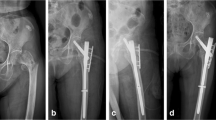Abstract
Background
The Trigen short reconstruction trochanteric antegrade nail (TAN) is considered most suitable for the small skeletons of Asian patients. We have evaluated the results of TAN for intertrochanteric fractures in Asian patients.
Methods
Between January 2006 and March 2009, 174 fractures in 164 patients were treated by TAN in our department. Epidemiological data, radiological changes, fracture types, cortical bone indices, clinical outcomes, and complications over a mean of 26 months were analyzed retrospectively.
Results
We observed a 17.0% fracture rate at the tip of the nail, a poor reduction rate of 15.9%, and a 41.4% cracking rate of the lateral trochanter for type 31-A3 fracture. Review of these cracking cases showed that they were all type 31-A3 unstable fractures combined with comminuted lateral trochanter fractures. Two shaft fractures required revision, with other fractures showing no delayed union, nonunion or infection. No screw breakage but one cut-out occurred, which received total hip arthroplasty revision. All other fractures healed at last. Risk of distal shaft fractures was not associated with patient age, gender, fracture type or cortical bone index.
Conclusion
Despite the theoretically better design of TAN and the healing of most fractures and good activity at last follow-up, poor reduction and coxa vara caused by insertion of the nail could not be completely avoided, and the design of the distal part of the nail had the potential to cause femoral shaft fracture. Future improvements are necessary to enable the use of this system in Asians.



Similar content being viewed by others

References
Min WK, Kim SY, Kim TK, Lee KB, Cho MR, Ha YC, Koo KH (2007) Proximal femoral nail for the treatment of reverse obliquity intertrochanteric fractures compared with gamma nail. J Trauma 63:1054–1060
Yaozeng X, Dechun G, Huilin Y, Guangming Z, Xianbin W (2010) Comparative study of trochanteric fracture treated with the proximal femoral nail anti-rotation and the third generation of gamma nail. Injury 41:1234–1238
Hesse B, Gachter A (2004) Complications following the treatment of trochanteric fractures with the gamma nail. Arch Orthop Trauma Surg 124:692–698
Hwang JH, Oh JK, Han SH, Shon WY, Oh CW (2008) Mismatch between PFNa and medullary canal causing difficulty in nailing of the pertrochanteric fractures. Arch Orthop Trauma Surg 128:1443–1446
Forte ML, Virnig BA, Kane RL, Durham S, Bhandari M, Feldman R, Swiontkowski MF (2008) Geographic variation in device use for intertrochanteric hip fractures. J Bone Joint Surg Am 90:691–699
Leung KS, Procter P, Robioneck B, Behrens K (1996) Geometric mismatch of the Gamma nail to the Chinese femur. Clin Orthop Relat Res 323:42–48
Pu JS, Liu L, Wang GL, Fang Y, Yang TF (2009) Results of the proximal femoral nail anti-rotation (PFNA) in elderly Chinese patients. Int Orthop 33:1441–1444
Bojan AJ, Beimel C, Speitling A, Taglang G, Ekholm C, Jonsson A (2010) 3066 consecutive Gamma nails. 12 years experience at a single centre. BMC Musculoskelet Disord 11:133
Lyddon DJ (1996) The prevention of complications with the Gamma locking nail. Am J Orthop (Belle Mead NJ) 25:357–363
Wu PK, Chen WM, Chen CF, Lee OK, Haung CK, Chen TH (2009) Primary osteogenic sarcoma with pulmonary metastasis: clinical results and prognostic factors in 91 patients. Jpn J Clin Oncol 39:514–522
Frank M (2011) Classifications of trochanteric fracture patterns. Orthopedie. http://www.maitrise-orthop.com/corpusmaitri/orthopaedic/mo65_trochanteric_fracture/index.shtml. Assessed 15 April 2011
Bridle SH, Patel AD, Bircher M, Calvert PT (1991) Fixation of intertrochanteric fractures of the femur. A randomised prospective comparison of the gamma nail and the dynamic hip screw. J Bone Joint Surg Br 73:330–334
Zafiropoulos G, Pratt DJ (1994) Fractured Gamma nail. Injury 25:331–336
Bhandari M, Schemitsch E, Jonsson A, Zlowodzki M, Haidukewych GJ (2009) Gamma nails revisited: gamma nails versus compression hip screws in the management of intertrochanteric fractures of the hip: a meta-analysis. J Orthop Trauma 23:460–464
Docquier PL, Manche E, Autrique JC, Geulette B (2002) Complications associated with gamma nailing. A review of 439 cases. Acta Orthop Belg 68:251–257
Schipper IB, Steyerberg EW, Castelein RM, van der Heijden FH, den Hoed PT, Kerver AJ, van Vugt AB (2004) Treatment of unstable trochanteric fractures. Randomised comparison of the gamma nail and the proximal femoral nail. J Bone Joint Surg Br 86:86–94
Simmermacher RK, Bosch AM, Van der Werken C (1999) The AO/ASIF-proximal femoral nail (PFN): a new device for the treatment of unstable proximal femoral fractures. Injury 30:327–332
Richmond J, Aharonoff GB, Zuckerman JD, Koval KJ (2003) Mortality risk after hip fracture. J Orthop Trauma 17:53–56
Rosenblum SF, Zuckerman JD, Kummer FJ, Tam BS (1992) A biomechanical evaluation of the Gamma nail. J Bone Joint Surg Br 74:352–357
Yan S, Zhao X, Li H, Zheng Q, Li J, Pan Z, Wu H (2011) Comparison of percutaneous compression plating and short reconstruction nail for treatment of intertrochanteric fracture. Orthop Surg 3:14–21
Winquist RA, Hansen SJ, Clawson DK (1984) Closed intramedullary nailing of femoral fractures. A report of five hundred and twenty cases. J Bone Joint Surg Am 66:529–539
Acknowledgments
This work was supported by Research Program of Zhejiang Provincial Health Department (N20100757).
Conflict of interest
The authors have no financial ties to any of the companies that manufacture the materials used in the current study. There is no conflict of interest in this study.
Author information
Authors and Affiliations
Corresponding author
Rights and permissions
About this article
Cite this article
Zhao, X., Yan, SG., Li, H. et al. Short reconstruction nail for intertrochanteric fracture: does it really fit Asian feature?. Arch Orthop Trauma Surg 132, 81–86 (2012). https://doi.org/10.1007/s00402-011-1365-7
Received:
Published:
Issue Date:
DOI: https://doi.org/10.1007/s00402-011-1365-7



